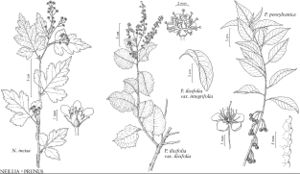Prunus pensylvanica
Suppl. Pl., 252. 1782.
Shrubs or trees, often suckering, 20–160 dm, not thorny. Twigs with terminal end buds, glabrous. Leaves deciduous; petiole (7–) 9–20 mm, glabrous, glandular distally, glands 1–3; blade elliptic, oblong-lanceolate, or lanceolate, (2.5–) 4.5–10 (–14) × 1.5–5 cm, base cuneate to rounded, margins crenulate to crenate-serrate, teeth blunt, glandular, apex usually acuminate, sometimes acute (western specimens), surfaces glabrous. Inflorescences 2–5 (–8) -flowered, umbellate fascicles or corymbs; central axes 0–8 (–24) mm. Pedicels (8–) 10–30 mm (subtended by minute bracts), glabrous. Flowers blooming at leaf emergence; hypanthium obconic, 1.8–3 mm, glabrous externally; sepals reflexed, oblong, 1.2–2.8 mm, margins entire, surfaces glabrous; petals white, elliptic, obovate, or suborbiculate, 4–7 mm; ovaries glabrous. Drupes bright red, ellipsoid, 6–10 mm, glabrous; mesocarps fleshy; stones ellipsoid, not flattened. 2n = 16.
Phenology: Flowering Apr–Jun; fruiting Jul–Aug.
Habitat: Forming thickets along streams and lakeshores, in clearings, roadsides, burned-over areas, disturbed sites, rocky hillsides, cliffs, open forests
Elevation: 0–2800 m
Distribution

St. Pierre and Miquelon, Alta., B.C., Man., N.B., Nfld. and Labr., N.W.T., N.S., Ont., P.E.I., Que., Sask., Colo., Conn., Ga., Ill., Ind., Iowa, Maine, Md., Mass., Mich., Minn., Mont., N.H., N.J., N.Y., N.C., N.Dak., Ohio, Pa., R.I., S.Dak., Tenn., Vt., Va., W.Va., Wis., Wyo.
Discussion
Throughout most of its range, Prunus pensylvanica appears distinct from P. emarginata. The leaves of P. pensylvanica are generally larger and lanceolate to ovate-lanceolate rather than oblanceolate to elliptic; the leaf apices are usually acuminate (sometimes acute) versus rounded to obtuse (rarely acute) in P. emarginata. Inflorescences of P. pensylvanica are corymbose to umbellate with central axes shorter than pedicels; in P. emarginata the inflorescences are corymbose to racemose with central axes longer than pedicels. Where their ranges overlap in British Columbia and western Montana, intermediates are found with the corymbose inflorescence of P. emarginata and leaves more comfortably accommodated within the variation of P. pensylvanica. Some of these specimens have been identified as P. corymbulosa, based on a type from Montana, here included within P. pensylvanica.
Along the eastern slopes of the Rockies and throughout the northwestern Great Plains, Prunus pensylvanica is shrubby and has smaller leaves (less than 60 mm) than it does farther east. Compared to leaves of eastern plants, those of western specimens are also broader in proportion to their length (1.7–2.3:1 versus 2–4.3:1), have acute rather than acuminate apices, and tend to be more coarsely toothed. Although sometimes segregated as var. saximontana, or subsp. corymbulosa, when having a corymbose inflorescence, these plants fit within the variation in plant habit, leaf size, leaf shape, and margin serration seen throughout the broad range of P. pensylvanica.
Selected References
None.
